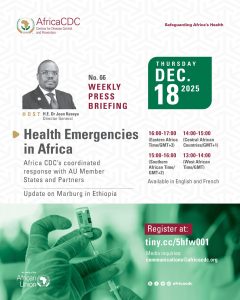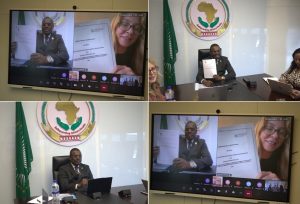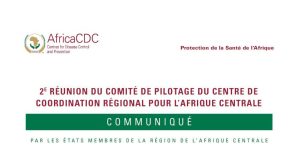ADDIS ABABA, ETHIOPIA, 27 June 2022 – Since the beginning of 2022, 1,715 cases (1,636 suspected; 79 confirmed) and 73 deaths (CFR: 4.3%) of monkeypox have been reported from eight endemic and two non-endemic African Union (AU) Member States (MS). During the period of the COVID-19 pandemic (February 2020 to date), Africa has documented 12,141 cases and 363 deaths (CFR 3%) of monkeypox. The number of cases has continued to rise on the continent.
Monkeypox is a viral zoonosis belonging to the Poxviridae family (the same viral family that caused smallpox). The first human case of monkeypox was reported in 1970 from the Democratic Republic of the Congo (DRC). The virus is thought to be maintained primarily in wild rodent populations.
Monkeypox can be transmitted via direct contact with infected body fluids or lesion material from humans or animals, or indirect contact with contaminated material. Human-to-human transmission is thought to occur primarily through large respiratory droplets. Symptoms typically include fever, headache, malaise, muscle aches, and swollen lymph nodes, followed a few days later by a rash. Complications of monkeypox infections include secondary infections, bronchopneumonia, sepsis, encephalitis, and infection of the cornea with ensuing loss of vision. Immunocompromised persons may progress to severe forms. For survivors, long term complications are most commonly scarring or skin pigmentation changes, but rarely eye involvement can cause loss of vision[1].
Outside of the African continent since 13 May 2022, and as of 24 June 2022, 4,104 confirmed cases and one death of monkeypox have been reported from 45 countries that are not endemic for monkeypox. These countries are mainly in Europe and North America[2].
On 23 June 2022, the World Health Organization’s (WHO) International Health Regulations 2005 (IHR) Emergency Committee held a meeting to discuss the ongoing multi-country monkeypox outbreak. The Committee decided that the current multi-country outbreak does not constitute a Public Emergency of International Concern (PHEIC) at this stage given:
- Plateauing or downward trends in case numbers from the countries experiencing earlier outbreaks
- Low severity of cases (e.g. low mortality and hospitalization rates)
- Knowledge gaps and areas of uncertainty for which more information is needed to support a more comprehensive assessment of the public health risk
Africa CDC has continued to monitor the situation of monkeypox on the continent and globally, while supporting AU MS in their efforts to strengthen surveillance systems in-country and across borders. The tools required to contain this expanding outbreak include diagnostics, vaccines, and therapeutics, all of which are currently not easily accessible to AU MS. The technical and financial resources required to effectively respond to monkeypox in Africa are not yet optimally mobilised. Monkeypox remains a public health emergency in affected African countries, and is a high risk pathogen for other neighbouring countries.
Africa CDC recommends that AU MS should remain vigilant. In doing this, AU MS are advised to:
- Establish and/or strengthen laboratory diagnostic and genomic sequencing capacity for orthopoxviruses, including monkeypox.
- Establish and/or strengthen existing monkeypox surveillance efforts, including cross-border surveillance.
- Develop and distribute both general and tailored risk communication messages for the community at large as well as specific populations currently impacted and at risk (e.g., sex-workers, immunocompromised individuals, children, etc.).
- Strengthen knowledge of monkeypox clinical management and infection prevention control measures across all cadres of health workers.
- Report new cases of monkeypox as part of the current multi-country outbreak to Africa CDC (AfricaCDCEBS@Africa-Union.org)
AFRICA CDC RESPONSE EFFORTS
- The Africa CDC Emergency Operations Centre remains in alert mode and is closely monitoring the situation globally and in Africa.
- The Africa CDC Laboratory Division, in collaboration with the Nigerian CDC and African Society for Laboratory Medicine (ASLM), is training 20 AU MSs on monkeypox virus diagnostics in Abuja, Nigeria between 28-30 June 2022. Africa CDC will also distribute more than 3,600 test kits to AU MSs to support surveillance and detection needs in both endemic and non-endemic countries.
- The Africa CDC Pathogen Genomics Institute is also coordinating with AU MS to provide sequencing support.
- The Africa CDC Emergency Preparedness and Response Division has engaged the MoH of at least four MS (Cameroon, Central Africa Republic, DRC, and Nigeria) to identify areas of potential support.
- The Africa CDC Regional Collaborating Center for Central Africa Region is providing technical support to the Gabonese MoH for the development of a preparedness and response plan between 27-30 June 2022 in Libreville, Gabon.
Africa CDC urges AU MS, partners and friends of Africa to support the monkeypox emergency support efforts across the continent while coordinating closely with the Africa CDC and the AU. The Africa CDC also urges more tools, including diagnostics, therapeutics and vaccines, be made available in Africa so as to ensure that the outbreak does not spread further nor grow more severe.
About the Africa CDC
The Africa CDC mission is to strengthen Africa’s public health institution’s capacities, capabilities and partnerships to detect and respond quickly and effectively to disease threats and outbreaks based on science, policy, and data-driven interventions and programmes. Learn more at: https://africacdc.org
About the African Union The African Union spearheads Africa’s development and integration in close collaboration with African Union Member States, the Regional Economic Communities and African citizens. AU Vision: to accelerate progress towards an integrated, prosperous and inclusive Africa, at peace with itself, playing a dynamic role in the continental and global arena, effectively driven by an accountable, efficient and responsive Commission. Learn more at: http://www.au.int/en/
[1] US CDC – https://www.cdc.gov/poxvirus/monkeypox/index.html
[2] US CDC – https://www.cdc.gov/poxvirus/monkeypox/response/2022/world-map.html







